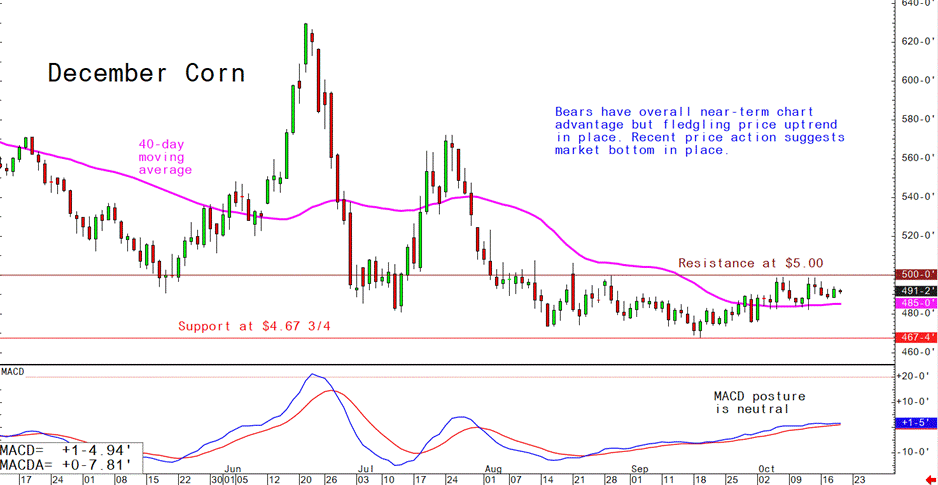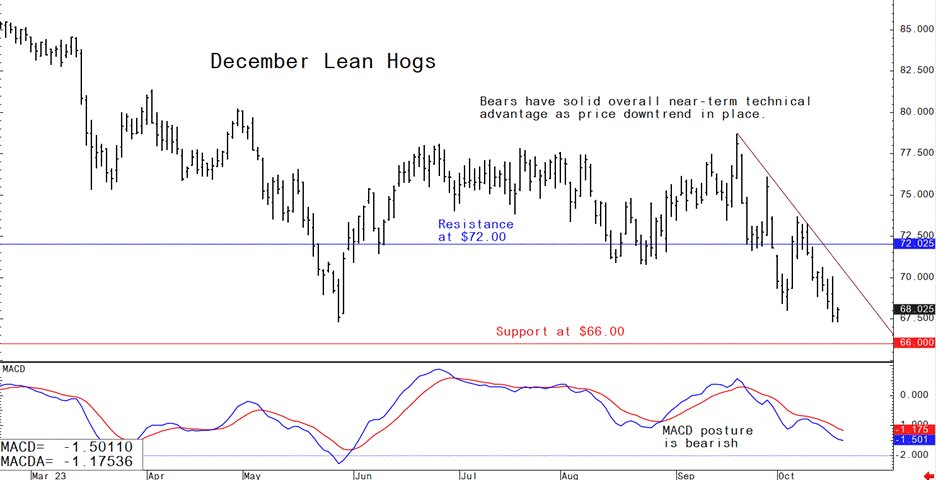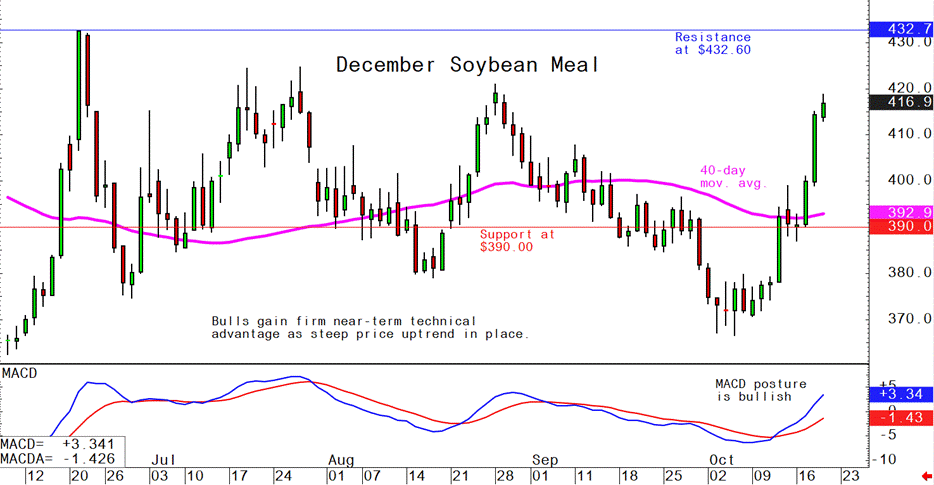



Pig outlook: Lean hog bears in firm technical control, Smithfield, pork world market report
Livestock analyst Jim Wyckoff shares global pig newsThe lean hog futures bears have the solid near-term technical advantage as December hogs this week hit a new contract low and prices are trending lower on the daily bar chart. That suggests the path of least resistance for prices will remain sideways to lower for the near term. Wholesale pork prices continue to slip this week. The latest CME lean hog index fell 45 cents to $81.15 (as of Oct.16). Many futures traders continue to believe weakness in the cash hog market will continue in the coming weeks. Still-elevated cattle feedlot prices and still-high beef prices at the meat counter could soon put a floor under the hog and fresh pork markets, on better substitution demand from the consumer.
Weekly USDA US pork exports sales
Pork: Net sales of 30,700 MT for 2023 up 46 percent from the previous week and 10 percent from the prior 4-week average. Increases were primarily for Mexico (9,100 MT, including decreases of 200 MT), Japan (6,200 MT, including decreases of 300 MT), South Korea (4,000 MT, including decreases of 400 MT), China (2,000 MT, including decreases of 100 MT), and Colombia (1,900 MT, including decreases of 100 MT). Total net sales of 900 MT for 2024 were for South Korea. Exports of 25,800 MT were down 8 percent from the previous week and from the prior 4-week average. The destinations were primarily to Mexico (8,700 MT), Japan (3,800 MT), China (2,800 MT), South Korea (2,200 MT), and Canada (2,100 MT).
China pork imports plunge vs. year-ago in September
China imported 110,000 MT of pork during September, equal to the amount it brought in during August but 31.7% less than last year. Pork imports through the first nine months of this year totaled 1.27 MMT, up 4.4% from the same period last year.
China’s Q3 pork output soars
China’s pork output in the third quarter rose 4.8% from year-ago to 12.69 MMT, the highest for the quarter in at least a decade. Pork output in the first nine months of this year rose 3.6% from the same period last year to 43.01 MMT. China’s hog herd rose to 442.29 million head at the end of September, up 7.12 million head (1.6%) from the previous quarter, but down 0.4% from last year.
USDA Livestock Outlook: October 2023
Pork/Hogs: USDA’s September Quarterly Hogs and Pigs reported a small increase in market hogs, a modest decline in the breeding inventory, and across-the-board reductions in farrowings —both actual (June–August) and producers’ intentions for September–November and December–February. The June–August litter rate was record high at 11.61 pigs per litter. New information from the September report suggests that 2023 hog prices will likely average about $60 per hundredweight (cwt) this year on a total pork production increase of about 1.1 percent. In 2024, hog prices are forecast to average about $61 per cwt on a total pork production increase of 2.2 percent.
USDA sends final rule on livestock markets to OMB, aims to promote ‘inclusive competition’
USDA submitted a final rule titled “Inclusive Competition and Market Integrity Under the Packers and Stockyards Act” to the Office of Management and Budget (OMB). This rule encompasses “proposed revisions” to regulations under the Packers and Stockyards Act (PSA), with the objective of promoting inclusive competition and market integrity within the livestock, meats, poultry and live poultry markets. The Agricultural Marketing Service has clarified that the rule includes “supplemental amendments” aimed at defining conduct that USDA considers “unfair, preferential, unjustly discriminatory, or deceptive, and a violation of the PSA.” It also seeks to clarify criteria and types of conduct that would be viewed as “unduly or unreasonably preferential, advantageous, prejudicial, or disadvantageous, and violations of the Act, including retaliatory practices that interfere with lawful communications, assertion of rights, and associational participation.” Notably, USDA has another final rule related to transparency in poultry grower contracting and tournaments currently under review at OMB. Despite scheduled meetings concluding by late September, it remains uncertain when either rule will be published, as the recently submitted rule was originally targeted for finalization in September.
Smithfield prepares for US stock listing
Smithfield Foods’ Chinese owner WH Group is working with banks to take the US-based pork producer public again in the US, the Wall Street Journal reported, citing people familiar with the matter. “The company regularly evaluates relisting Smithfield’s stock in the US, but there is no time-table for it,” WH Group said in an emailed statement to Reuters. Other major meat companies, like Brazil’s JBS, are also considering US. listings amid challenging conditions in the industry.
China lifts FMD ban on some Russian regions
China lifted a ban on foot and mouth disease (FMD) for sheep, cattle and pigs in 22 Russian regions. China’s ag ministry says livestock and their products from these regions that comply with Chinese laws are allowed to enter the country.
Iowa joins pork producers in legal challenge against Massachusetts pork sale restrictions
Iowa has entered the legal fray by challenging a recently enacted Massachusetts law that prohibits the sale of pork not meeting specific hog-confinement standards, according to the Iowa Capital Dispatch. This legal action comes as part of an ongoing dispute involving pork producers, including Triumph Foods, who have sued the Massachusetts attorney general over the Prevention of Farm Animal Cruelty Act.
Key points:
- Massachusetts' Prevention of Farm Animal Cruelty Act restricts the sale and transportation of pork within the state, imposing strict hog-confinement standards.
- The law goes beyond California's similar legislation by also banning the transport of non-compliant pork through Massachusetts to other states.
- The law aims to prevent animal cruelty and improve food safety but has faced opposition from pork producers, who argue that the confinement standards are inconsistent with industry practices and could impose costly burdens.
- Iowa, the leading pork producer and exporter in the United States, filed an amicus brief supporting the pork producers' challenge. The brief emphasizes the potential negative economic impact on the state's pork industry.
- The amicus brief argues that the Massachusetts law sets a dangerous precedent by allowing states to disrupt markets based on political agendas and asserts that the law violates the US Constitution's commerce clause and import-export clause.
- Lawyers for Massachusetts contend that some of these legal arguments have been rejected in previous court cases, including a Supreme Court ruling involving California's similar legislation.
Bottom line: The legal battle centers on whether states have the authority to enact laws affecting interstate commerce, potentially impacting the pork industry and the sale of pork products across state lines.
USDA Livestock and Poultry: World Markets and Trade
Pork: In 2024, EU pork exports are expected to decline 25 percent compared to 2019 and account for 15 percent of production, down from 19 percent in 2019. In addition to growing regulatory burdens, EU swine producers continue to face challenges controlling the impact of African swine fever, which has led to reductions in the swine herd and limited exports to some markets. As production contracts, the share intended for domestic consumption has grown at the expense of exports.
Details on Pork: Global production in 2024 is forecast virtually unchanged year over year at 115.5 million tons as lower production in the EU and China is mostly offset by larger production in Brazil, Vietnam, and the United States. EU pork production is forecast 2 percent lower year over year to 21.2 million tons. The EU sow herd continued to decline in 2023 and is forecast at 10.3 million head in 2024, down 1 percent. Feed prices have moderated and sector profitability improved in 2023. However, weak domestic demand and the lack of new export markets to replace China are expected to lead to industry restructuring in 2024 as producers seek to align production with lower total demand. China production is forecast 1 percent lower as weak domestic demand has led to large industry losses through most of 2023, encouraging producers to reduce production. Brazil production is forecast 5 percent higher year over year as hog prices reflect growth in a number of export markets, including Mexico, Singapore, and the Dominican Republic and input costs are expected to decline, leading to improved producer margins.
Vietnam production is forecast to increase 5 percent to 3.7 million tons on recovering domestic demand as a result of economic recovery following COVID-19 and efficiency gains from industry investment and consolidation. Global exports are forecast to increase 2 percent to 10.4 million tons in 2024 as Brazil exports continue to gain market share from EU and US pork products, particularly in Japan, and Mexico. United Kingdom exports are forecast to increase 9 percent as lower input prices and higher pig prices are expected to lead to greater supplies available for export to the EU and China. Global pork imports are forecast to increase by 1 percent in 2024 with increases from Hong Kong,
China and Japan more than offsetting lower imports from Taiwan and the United Kingdom. US production and exports: US production is forecast 2 percent higher in 2024 to 12.7 million tons on a strong increase to pigs per litter and falling feed costs. US exports are forecast to increase 3 percent in 2024 on strong demand from Canada, the Philippines, and South Korea as well as gaining market share from the EU in China and Australia.
The next week’s likely high-low price trading ranges:
December lean hog futures--$66.00 to $71.00 and with a sideways-lower bias
December soybean meal futures--$400.00 to $435.00, and with a sideways-higher bias
December corn futures--$4.67 3/4 to $5.10 and a sideways bias
Latest analytical daily charts lean hog, soybean meal and corn futures












